
Adetomyrma is a genus of ants endemic to Madagascar. Workers of this genus are blind. The type species Adetomyrma venatrix was described in 1994, with the genus being an atypical member of its tribe, the Amblyoponini. This tribe includes the Dracula ants, members of which can feed on the hemolymph of larvae and pupae.

The Gasteruptiidae are one of the more distinctive families among the apocritan wasps, with surprisingly little variation in appearance for a group that contains around 500 species in two subfamilies and with 6 genera worldwide. They are members of Evanioidea.

The Saint Helena olive is an extinct species of flowering plant. It is the only member of the genus Nesiota. It was endemic to the island of Saint Helena in the South Atlantic Ocean. Despite its name, it is unrelated to the true olive, but is instead a member of the family Rhamnaceae, the family which contains buckthorns and jujube. The last remaining tree in the wild died in 1994, and the last remaining individual in cultivation died in December 2003, despite conservation efforts. It is thus a prime example of recent plant extinction. The Saint Helena olive belongs to the tribe Phyliceae, which are mostly endemic to Southern Africa.
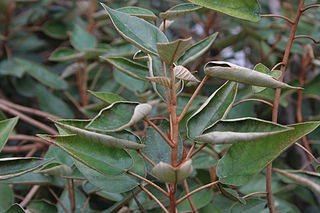
The flowering plant genus Trochetiopsis consists of two extant and one extinct species endemic to the island of Saint Helena. They were formerly placed in the family Sterculiaceae, but this is included in the expanded Malvaceae in the APG and most subsequent systematics.

Nesohedyotis is a genus of flowering plants endemic to the island of Saint Helena in the South Atlantic Ocean. It in the family Rubiaceae.

Andrena is a genus of bees in the family Andrenidae. With over 1,500 species, it is one of the largest genera of animals. It is a strongly monophyletic group that is difficult to split into more manageable divisions; currently, Andrena is organized into 104 subgenera. It is nearly worldwide in distribution, with the notable exceptions of Oceania and South America. Bees in this genus are commonly known as mining bees due to their ground-nesting lifestyle.
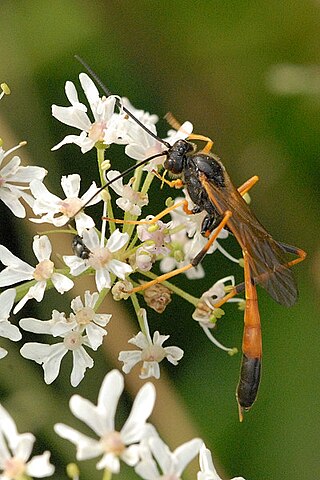
Anomaloninae is a subfamily of parasitoid wasps in the family Ichneumonidae. Several species provide beneficial services to humans by attacking forest or orchard pests.
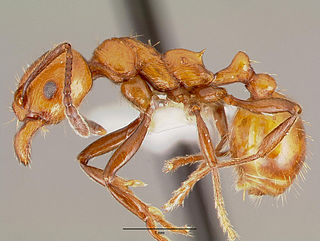
Huberia is a genus of ants in the subfamily Myrmicinae. The genus contains two species endemic to New Zealand.

Mymarilla wollastoni is a species of fairyflies endemic to the island of Saint Helena in the southern Atlantic. It is the only species classified under the genus Mymarilla. They are characterized by relatively smooth, shiny black bodies and densely hairy (setose) and domed forewings. They bear superficial resemblance to members of the genus Cremnomymar which inhabit similar habitats of remote wind-swept oceanic islands, but they are believed to be most closely related to the genus Stephanodes. They were first described by the English entomologist John Obadiah Westwood in 1879, from specimens collected from low-lying plants in Saint Helena.

Linepithema cryptobioticum is a species of ant in the genus Linepithema. Described by Wild in 2007, the species is endemic to South America.
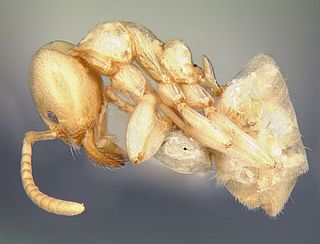
Linepithema flavescens is a species of ant in the genus Linepithema. Described by William Morton Wheeler and Mann in 1914, the species is endemic to Haiti.

Anomalon is a large genus of parasitoid wasps belonging to the family Ichneumonidae. This may be the only genus in the tribe Anomalonini, although Neogreeneia Viereck, 1912 is sometimes considered a valid genus of the tribe.
Habronyx minutus is a species of small parasitic wasp in the subfamily Anomaloninae of family Ichneumonidae. It has a length of 5.5 to 8 millimetres. The species was described by D. F. Ward in 2015, and the holotype was collected in December 1980 at Pelorus Bridge.

Sericomyrmex radioheadi is a species of ant in the genus Sericomyrmex. Described by Ana Ješovnik and Ted R. Schultz in 2017, the species is endemic to Venezuelan Amazonia. The species is named after the British rock band Radiohead. Female members of the species have a white, crystal-like layer covering their bodies, but this layer is absent from the males.

Gravenhorstiini is a large tribe of parasitoid wasps belonging to the family Ichneumonidae It contains all the genera of the subfamily Anomaloninae, excepting Anomalon.
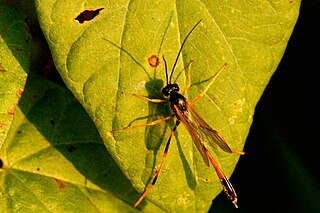
Heteropelma is a genus of parasitoid wasps belonging to the family Ichneumonidae. Species in this genus are around 25 mm in length.
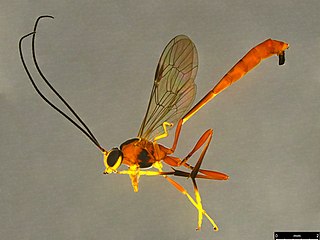
Habronyx is a genus of parasitoid wasps belonging to the family Ichneumonidae. The species of this genus are found in Europe, Australia, and North and South America.

Bulbostylis lichtensteiniana is a species of flowering plant in the sedge family, Cyperaceae, that is endemic to Saint Helena. Unlike other species native to Saint Helena, such as Bulbostylis neglecta, Bulbostylis lichtensteiniana does not show obvious signs of decline due to the spread of invasive plants. However, the lack of decline is partially attributed to Bulbostylis lichtensteiniana being the only endemic plant to have expanded into new anthropogenic habitats.
Habronyx fulvipes is a species of parasitic ichneumon wasp. It was renamed by Townes, Momoi and Townes in 1965 ; prior to that the species had been named Habronyx chinensis, chinensis meaning "China", in 1955 by Japanese entomologist Toichi Uchida. The holotype and allotype were collected by R. Mell. The species was first named Exochilum Chinense by Morley in 1913.


















